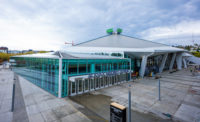Seattle’s Climate Pledge Arena is aiming to be the first International Living Future Institute Zero Carbon certified professional sports venue in the world.
National Hockey League Seattle, the city-owned arena developer Oak View Group and Amazon formed a partnership to show "what ambitious climate action looks like," says Jason F. McLennan, CEO of McLennan Design, founder and board member of the International Living Future Institute, sustainability advisor to the expanded arena project and the 2016 ENR Award of Excellence winner. “It will now be the greenest arena in the world,” he says.
McLennan is hopeful that if an 18,100-seat redeveloped arena can earn Zero Carbon Certification, any project can—as long as action on climate change is made an urgent priority.
The institute’s Zero Carbon Certification requires 100% of the energy used to operate the building be offset by new renewable energy. In addition, all of the embodied carbon emissions associated with the construction and materials of the project must be disclosed and offset. Zero Carbon Certification is the first worldwide program to independently verify claims about “net zero carbon” and “carbon neutral” buildings.
“As a co-founder and signatory of the Climate Pledge, we’re committed to meeting the goals of the Paris Agreement 10 years early and reaching net zero carbon by 2040,” said Kara Hurst, vice president of sustainability, Amazon, in a statement. “Climate Pledge Arena will … serve as a constant reminder of the importance of fighting climate change through real, sustainable changes to our built environment.”
Only Renewable Energy
The arena, scheduled to open next year, is on deck to be the first arena powered only by renewable energy—including both onsite and offsite solar installations—rather than natural gas that had been used. The arena will run solely on electricity for daily operations. It will also have the first all-electric dehumidification system in the National Hockey League. And ice will be made using rainwater and refrigerants with zero greenhouse gas emissions.
“We ripped out all the natural gas infrastructure,” says McLennan.
In the reconstruction, saving the landmark roof and digging out a larger subterranean footprint significantly reduced new façade materials needed and reduced the associated greenhouse gas emissions in their supply.
The arena, with a cable-stayed roof, was originally constructed in 1962. A major rebuild opened in 1995. It included excavating the arena bowl an additional 35 ft and building a mostly new roof using four original trusses and replacing the cables with more than 260 new trusses. The current update retained the rebuilt roof, but everything underneath was removed and replaced.
To make it work, crews under the direction of Mortenson Construction erected falsework to temporarily support the 22,000-ton roof. They then removed everything below the roof, excavated another 15 ft and rebuilt the arena and new permanent roof supports. The result is a venue nearly double in size.






Post a comment to this article
Report Abusive Comment